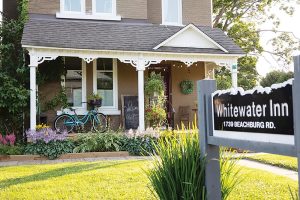Local developers say a pilot project to reduce parkland fees for office-to-residential conversions is a good step, but more measures are needed to make such projects financially feasible.
On Wednesday, the city’s planning and housing committee approved recommendations from staff to streamline the approval process and lower some fees in hopes of encouraging more developers to take on office-to-residential projects.
The committee also approved a motion brought forward by Somerset Coun. Ariel Troster to reduce the amount of parkland fees developers pay on such projects in her downtown ward for the next two years.
OBJ360 (Sponsored)

Your next memorable getaway awaits in Whitewater Region
If you’re eager to immerse yourself in some quintessentially Canadian experiences, look no further than Whitewater Region in the County of Renfrew, in the Upper Ottawa Valley. It’s a four-season

Ottawa startup WicWac responds to service industry needs with mobile business platform
WicWac was born from observing hardworking service professionals juggle too much – rushing between jobs, managing phone calls, and still trying to make it home for dinner. Many mobile professionals
Kelly Rhodenizer, vice-president of commercial and multi-family development at Regional Group, said the city is moving in the right direction, though there’s more work to be done.
“The city has made great efforts and I really appreciate the direction we’re going,” she said. “I really think they’re trying to help and move things faster in the right direction.”
At the same time, however, Rhodenizer says the new measures to reduce fees and spark new conversions “don’t move the needle to get me to pull the trigger to convert.”
Cash-in-lieu of parkland fees are paid by developers to the city as an alternative to dedicating a portion of land on the property for park purposes. For office buildings, the rate is fairly low at just two per cent of the land’s value, while rates for residential developments range between five and 10 per cent.
Developers working on office-to-residential conversions are currently required to pay 10 per cent cash-in-lieu of parkland fees, according to Rhodenizer. Troster’s proposed pilot project will cap the rate for downtown conversions at eight per cent.
Because the buildings used for conversions were once office buildings, Rhodenizer would like to see the city introduce measures to automatically credit the two per cent CIL fee already paid on the property to the developers.
“Both CLV (Group) and myself have made the argument that it should be three per cent for conversions,” she said. “You’ve already paid the two per cent for the office; you shouldn’t have to pay it again.”
Rhodenizer adds that for some office buildings, it can be difficult to track down documentation.
“It’s so hard to find records of things that were built in the ’40s, ’50s and ’60s to show proof of payment, but they would’ve been paid because the planning act required it,” she said.
For an already expensive project like a conversion, she said reducing parkland fees can make a difference of hundreds of thousands of dollars.
“The returns on the projects are so sensitive right now because interest rates are so high and rent rates are fluctuating,” she said. “That $500,000 to a million dollars on a project of this size actually is impactful. But when I look at the reduction in fees that the city is talking about, that could be 20 to 50 grand in savings; that’s not as impactful.”
CLV Group is one company working on office-to-residential conversions in the downtown core, with one project currently in progress on Laurier Avenue West.
Prior to that, the company completed another conversion on Albert Street called The Slayte, which contains 158 residential units.
CLV Group paid the city more than $1 million in parkland fees for that project, the firm’s president, Oz Drewniak, said.
“That’s more than we spent on our kitchens for the cabinets, counters, and finishes,” he added. “It’s a huge amount of money. These are real big dollars that can go towards the conversion of the actual property.”
Drewniak said he’s been pleased with the city’s commitment to making improvements to the conversion approval process for developers. While he thinks the CIL pilot is a good step, he’d like to see further measures implemented.
“It’s a start,” he said. “Many buildings have already paid some sort of CIL in the past, so I don’t know in all cases if it will have the intended effect they’re looking for or the intended offsets that they’re hoping to provide.”
Drewniak noted that transforming an empty office into apartments can ultimately cost just as much as constructing a new building from scratch. As a result, he said governments need to do more to entice developers to take on such a financial commitment.
“These are really large and risky projects,” he said. “Some others have attempted it, but they can’t make the math work. A two per cent reduction in parkland (fees), although it’s helpful, it’s not the meaningful offset that these conversions really need.”
Full council will consider the proposal at its next meeting on Nov. 8.





